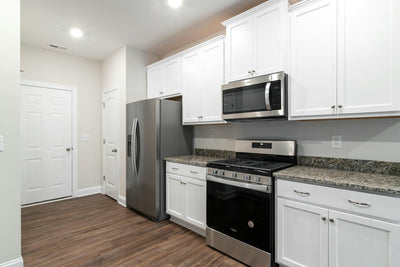Understanding Refrigeration Options
Importance of Choosing the Right Fridge and Freezer
When it comes to selecting the perfect cooling appliance for your living space, whether it be a home, apartment, or office, the importance of making an informed decision cannot be overstated. The right fridge or freezer not only preserves your food under optimal conditions but also complements your lifestyle and space constraints. With an array of options available, from chest refrigerators to small freezers, your choice can significantly impact your daily routine, energy consumption, and even your culinary experience.
Overview of Reach-In Freezers and Refrigerator Drawers
In the realm of refrigeration, two popular choices have emerged: the reach-in freezer and the refrigerator drawer. Each serves a unique purpose and offers different benefits to suit your refrigeration needs.
Reach-In Freezers: Reach-in freezers stand upright and are known for their ease of organization and accessibility. They are a staple in many homes and businesses, providing ample space for frozen goods. These units typically come with multiple shelves and are ideal for high-volume storage. They can vary in size, from slim, space-saving models to larger, commercial-grade options.
Refrigerator Drawers: On the flip side, refrigerator drawers offer a modern, seamless integration into kitchen cabinetry. They are perfect for those who prioritize convenience and are looking to save space. These drawers can be installed at various heights, providing ergonomic access to fresh food items. They are also a versatile choice, as they can be placed in a variety of locations, like under countertops or even in bedrooms or home offices for easy access to snacks and beverages.
Understanding the distinction between a reach-in freezer and a refrigerator drawer is just the beginning. It's crucial to delve deeper into factors such as capacity, energy efficiency, and maintenance requirements to ascertain which appliance best fits your needs. Additional comparisons, like deep freezer vs. upright freezer or bottom freezer refrigerator vs. wine chiller, can also provide valuable insights as you navigate through your refrigeration options.
Reach-In Freezers
Design and Functionality of Reach-In Freezers
Reach-in freezers are designed for efficiency and accessibility. These units often come with one or more sections, each with a door that swings open to reveal the contents inside. Inside, you'll find shelves or racks that can be adjusted to accommodate different food items. The vertical design of reach-in freezers makes them ideal for kitchens with limited space.
When you're considering a reach-in freezer, think about how it will fit into your workflow. These units are straightforward to organize, and their upright design means you won't have to bend down repeatedly to reach items. For more comparisons between freezer types, you might explore the differences between deep freezer vs. upright freezer.
Pros and Cons of Reach-In Freezers
Reach-in freezers offer several advantages but also come with potential drawbacks. Below is a table summarizing the pros and cons:
| Pros | Cons |
|---|---|
| Space-efficient design suitable for tight spaces | Limited storage capacity compared to chest freezers |
| Easy to organize with adjustable shelving | May require more frequent defrosting |
| Generally easier to find and access items | Can be less energy-efficient than some models |
| Available in multiple sizes to fit various needs | Higher upfront cost than some other types of freezers |
The design of reach-in freezers allows for ease of access, which is a significant benefit if you frequently need to retrieve items. They're generally more user-friendly than chest freezers, where items can get buried under one another. However, they may not be as suitable for bulk storage due to their limited capacity compared to a chest refrigerator vs. small freezer.
In terms of energy efficiency, reach-in freezers can vary. Some models are designed to be highly energy-efficient, potentially saving you money on your utility bills in the long run. Compare them with other energy-saving options, such as an energy efficient refrigerator vs. reach in freezer, to determine the best fit for your needs.
Maintenance for reach-in freezers is typically straightforward. Regular cleaning and the occasional defrost (for models without an auto-defrost feature) will keep them running smoothly. For more tips on maintenance, check out our advice on maintaining reach-in freezers and refrigerator drawers.
When you're weighing the options between a reach-in freezer and other cooling solutions, consider your space, storage needs, and how often you need to access the contents. The right choice can make a significant difference in the functionality of your kitchen, whether you're in an apartment, a family home, or a professional culinary environment.
Refrigerator Drawers
Design and Functionality of Refrigerator Drawers
Refrigerator drawers are a modern refrigeration solution that offers a built-in or under-counter alternative to traditional refrigeration units. They are designed to provide flexible storage space that can be easily integrated into kitchen islands, home bars, or even in bedroom suites for convenience. These drawers operate similarly to standard refrigerators, maintaining a consistent temperature to keep food and beverages cool, but they pull out like drawers to allow for easy access and organization.
The functionality of refrigerator drawers is enhanced by their ability to be installed at a more accessible height compared to standard fridges, which often require bending down to access lower shelves. Additionally, refrigerator drawers can be customized with dividers and various temperature settings to suit specific storage needs, whether for produce, beverages, or specialty items.
Pros and Cons of Refrigerator Drawers
When considering a reach in freezer vs. refrigerator drawer, weighing the pros and cons of refrigerator drawers is essential for making an informed decision.
Pros:
- Space Efficiency: Refrigerator drawers can be fitted into smaller or unconventional spaces, making them an excellent choice for compact living areas or as an additional cooling space in large kitchens.
- Customizable Temperature Zones: Some models offer different temperature settings for each drawer, which can be tailored to the items being stored.
- Accessibility: The drawer design allows for easy access to contents without the need to bend down, which is particularly beneficial for those with mobility issues.
- Aesthetic Appeal: These units offer a sleek and seamless look that can complement modern kitchen designs.
Cons:
- Cost: Refrigerator drawers can be more expensive than traditional refrigerators due to their specialized design and integration capabilities.
- Storage Limitations: While convenient, refrigerator drawers generally provide less storage space than reach-in freezers, making them less suitable for large households or bulk storage.
- Maintenance: The drawer mechanism may require additional cleaning and maintenance to ensure smooth operation over time.
Understanding the design and weighing the pros and cons of refrigerator drawers are crucial steps in deciding if they are the right fit for your home. Consider how this refrigeration option compares to others, such as a reach in freezer vs. refrigerator drawer, to determine which will best meet your lifestyle and storage needs. Whether you opt for the sleek integration of refrigerator drawers or the spacious storage of a reach-in freezer, ensure that your choice aligns with your household requirements and preferences.
Capacity and Storage
Comparing Storage Space in Reach-In Freezers and Refrigerator Drawers
When deciding between a reach-in freezer and refrigerator drawers, one of the key considerations is the amount of storage space each option provides. Understanding the capacity of each can help you choose the solution that best fits your needs, whether you're storing bulk food items or looking for an easy-access spot for your daily essentials.
Reach-In Freezers
Reach-in freezers are known for their ample storage space, making them ideal for those who like to stock up on frozen goods or need to store large items. They come in various sizes, but even the most compact models offer significant freezing capacity.
| Size (Cubic Feet) | Approximate Capacity (Pounds of Food) |
|---|---|
| 20-30 | 700-1050 |
| 31-40 | 1085-1400 |
| 41-50 | 1435-1750 |
These units often feature multiple shelves and bins that can be adjusted or removed to accommodate items of varying sizes. If you're considering a reach-in freezer, think about the amount of space you have available and your storage needs. For comparisons with other freezer types, you might find our deep freezer vs. upright freezer article useful.
Refrigerator Drawers
Refrigerator drawers, on the other hand, offer a more compact and customizable refrigeration solution. They can be installed under counters or as part of your kitchen island, providing convenient access to frequently used items.
While refrigerator drawers may not offer the same capacity as reach-in freezers, they do provide a streamlined and efficient way to organize and access your refrigerated goods. This can be particularly advantageous for smaller living spaces or for specialized storage needs.
| Number of Drawers | Approximate Capacity (Cubic Feet) |
|---|---|
| 1-2 | 2-5 |
| 3-4 | 6-10 |
The table format for storage space comparisons provides a clear and concise way to present information that can be easily digested by readers at a Grade 8 reading level. For more information on space-saving refrigeration options, check out our guide on undercounter refrigerator vs. wine refrigerator.
Ultimately, the choice between a reach-in freezer and refrigerator drawers depends on your specific needs for capacity and storage. You may also want to consider other factors such as energy efficiency, which is covered in our energy efficient refrigerator vs. reach in freezer article. Balancing space considerations with accessibility, energy use, and maintenance requirements will help you make the right decision for your home or workspace.
Installation and Placement
When selecting between a reach-in freezer and a refrigerator drawer, the installation and placement are key factors that will affect your decision. Each has its own requirements and considerations that you should be aware of to ensure that the appliance fits seamlessly into your space and serves your needs.
Considerations for Installing Reach-In Freezers and Refrigerator Drawers
Reach-In Freezers
Reach-in freezers are typically stand-alone units that require a dedicated space in your home. Here are some considerations when installing a reach-in freezer:
-
Space Requirements: Ensure you have ample space not only for the unit itself but also for door clearance. This is important for both accessibility and ventilation.
-
Ventilation: Proper ventilation is crucial to prevent overheating and to maintain energy efficiency. There should be enough room around the unit for air to circulate.
-
Flooring: These units can be heavy, especially when filled, so it's important to have a level floor that can support the weight.
-
Electrical Requirements: Reach-in freezers usually require a standard electrical outlet, but it's essential to check if the unit needs a specific voltage or if it requires a dedicated circuit.
-
Location: Ideally, you want to place the freezer in a cool, dry area to enhance efficiency and performance. Avoid placing it near heat sources or areas with high humidity.
Refrigerator Drawers
Refrigerator drawers offer more flexibility in terms of installation and can be a sleek addition to your kitchen or bar area. Here are some installation considerations for refrigerator drawers:
-
Cabinet Integration: These drawers are often designed to be built into existing cabinetry. You'll need to ensure that there's enough space within your cabinets to accommodate the unit's dimensions.
-
Countertop Height: Since refrigerator drawers are accessed from the top, you’ll need to consider the height of the surrounding countertops for comfortable access.
-
Electrical Requirements: Similar to reach-in freezers, ensure that your kitchen or installation area has the proper electrical outlets and voltage for the refrigerator drawers.
-
Plumbing: Some refrigerator drawer models may include an ice maker or require a water line. If this is the case, you'll need to have plumbing in place or plan for its installation.
-
Ventilation: Just like reach-in freezers, refrigerator drawers need proper ventilation to operate efficiently. This is particularly important for built-in units to prevent overheating.
When planning the installation of either a reach-in freezer or refrigerator drawers, it's also wise to think about your personal habits and accessibility needs. For instance, if you entertain often, having a refrigerator drawer in your entertaining space could be convenient for guests to access beverages. On the other hand, if you're looking for significant frozen food storage, a reach-in freezer in your garage or basement might be more suitable.
Careful consideration of these factors will help you choose the right refrigeration option that not only fits your space but also enhances your lifestyle. Whether you're a culinary enthusiast in need of ample storage or someone who values the convenience of a chilled drawer within arm's reach, ensure that your installation and placement align with your daily needs and the design of your home.
Accessibility and Convenience
When choosing between a reach-in freezer and refrigerator drawers, accessibility and convenience play significant roles in your decision. Your daily routine, kitchen layout, and personal preferences will dictate which option serves you best.
Ease of Access in Reach-In Freezers vs. Refrigerator Drawers
Reach-in freezers are typically upright units with shelves that allow you to store and organize frozen goods efficiently. These units often offer eye-level access to frozen items, which means less bending and squatting when searching for your desired products. This can be especially beneficial for individuals who find it difficult to bend down frequently.
| Feature | Reach-In Freezer | Refrigerator Drawer |
|---|---|---|
| Eye-level Access | Yes | No |
| Bending/Squatting | Minimal | More Required |
| Organizational System | Shelves & Bins | Drawers |
Refrigerator drawers, on the other hand, are installed under countertops and can be pulled out for easy access. This design is ideal for ergonomic access, as you can see and reach all contents without the need to move items around. However, you may need to bend down to access drawers that are situated lower to the ground.
| Feature | Reach-In Freezer | Refrigerator Drawer |
|---|---|---|
| Ergonomic Access | Less | More |
| Visibility of Contents | Less | More |
| Bending/Squatting | Less | More |
Consider your physical comfort and how often you access your freezer or refrigerator. If you entertain frequently or cook in bulk, you may prefer the convenience of a reach-in freezer that provides quick access to larger volumes of frozen goods. For those with smaller kitchens or who prioritize a streamlined design, refrigerator drawers might be the more convenient choice, offering discreet storage and easy reach.
In terms of placement, reach-in freezers are often more flexible, as they can stand alone or fit alongside other appliances. Refrigerator drawers are typically built into cabinetry, which may require a more customized installation process. Consider the available space in your kitchen and whether you are looking for a more permanent solution or one that can adapt to changes in your living space or needs.
For more information on the installation and energy efficiency of these options, you may want to explore articles like energy efficient refrigerator vs. reach in freezer or built-in freezer vs. drawer freezer. Understanding the full scope of features, including those related to accessibility and convenience, will help you make an informed decision tailored to your lifestyle.
Energy Efficiency
Energy Consumption of Reach-In Freezers and Refrigerator Drawers
When you're comparing a reach-in freezer versus a refrigerator drawer, energy efficiency is a significant factor. Both have their energy demands, which can influence your utility bills and environmental footprint.
Reach-In Freezers
Reach-in freezers are typically larger than refrigerator drawers and, as such, may consume more energy overall. However, modern reach-in freezers are designed with efficiency in mind, often featuring better insulation and more accurate temperature control mechanisms to reduce energy waste.
| Reach-In Freezer Size | Approximate Annual Energy Use (kWh) |
|---|---|
| Small (7-14 cu.ft.) | 300 - 480 |
| Medium (14-18 cu.ft.) | 480 - 560 |
| Large (18+ cu.ft.) | 560 - 800 |
Keep in mind, the actual energy consumption can vary based on usage patterns, ambient temperature, and how full the freezer is kept. Consistently opening the door or leaving it ajar can lead to higher energy use.
Refrigerator Drawers
Refrigerator drawers are typically smaller and may be used less frequently than your main refrigerator or freezer, potentially leading to lower energy consumption. Some models are very energy efficient, utilizing a smaller compressor and fan. However, because these drawers are often integrated into cabinetry, installation and ventilation can impact their efficiency.
| Refrigerator Drawer Size | Approximate Annual Energy Use (kWh) |
|---|---|
| Small (2-3 cu.ft.) | 150 - 220 |
| Medium (3-5 cu.ft.) | 220 - 300 |
| Large (5+ cu.ft.) | 300 - 400 |
Choosing an energy-efficient model is key for long-term savings. For more information on energy consumption and how to choose an efficient appliance, visit our guide on energy efficient refrigerator vs. mini fridge.
When selecting between a reach-in freezer or refrigerator drawer, consider how often you'll access each appliance and what you'll store inside. If you have a large family or need significant storage space for frozen goods, a reach-in freezer might be more practical despite potentially higher energy use. However, for smaller spaces or less frequent use, a refrigerator drawer could offer the convenience and efficiency you need.
Keep in mind that the initial cost of the appliance is not the only expense; the energy consumption over time can add up. Always look for the ENERGY STAR label or similar certifications indicating high energy efficiency. In the long run, these models can help lower your electricity bills and support your eco-friendly lifestyle. For additional tips on maintaining your appliances for optimal efficiency, check out our article on maintaining reach-in freezers and refrigerator drawers.
Maintenance and Care
Proper maintenance and care are key to ensuring that your refrigeration appliances, whether a reach-in freezer or refrigerator drawer, function optimally and last for many years. Here are some tips to help you keep these appliances in top condition.
Tips for Maintaining Reach-In Freezers and Refrigerator Drawers
Reach-In Freezers
- Regular Cleaning: Schedule monthly deep cleans to prevent the buildup of ice and frost. Remove all items and wipe down the interior with a mild detergent.
- Door Seals: Check the door seals (gaskets) regularly for wear and tear. Clean them with a soft cloth and warm, soapy water to ensure they seal properly.
- Defrosting: If your reach-in freezer is not frost-free, defrost it regularly to prevent excessive frost accumulation, which can affect performance.
- Ventilation: Ensure there's adequate space around the freezer for proper air circulation. This helps the condenser coils dissipate heat and reduces energy consumption.
- Coil Cleaning: Dust and debris can accumulate on the condenser coils over time. Clean these coils every six months to maintain energy efficiency.
Refrigerator Drawers
- Spill Management: Clean up spills immediately to prevent odors and stains. Use a gentle cleaner to avoid damaging the interior surfaces.
- Drawer Alignment: Make sure the drawers are properly aligned and slide smoothly. Misalignment can cause wear and compromise the seal.
- Temperature Checks: Monitor the temperature settings periodically to ensure that the unit is operating at the correct temperature for your storage needs.
- Underneath Cleaning: Remove the drawers occasionally to clean the area underneath, where crumbs and debris can collect.
- Circulation: Do not overpack the drawers, as this can restrict airflow and lead to uneven cooling.
Proper maintenance not only extends the lifespan of your reach-in freezer or refrigerator drawer but also helps maintain the quality of the food stored within. By following these tips, you can ensure that your appliance operates efficiently and keeps your food fresh and safe.
Additionally, understanding the differences in energy consumption and efficiency between these appliances can also contribute to a more cost-effective operation. For insights into energy efficiency considerations, you may want to explore our comparison on energy efficient refrigerator vs. reach in freezer.
Whether you are a homeowner, chef, or someone who enjoys entertaining, maintaining your refrigeration appliances is a crucial aspect of kitchen management. Refer to our guides for further information on maintenance, such as deep freezer vs. upright freezer and drawer freezer vs. drink fridge, to ensure that you are equipped with the knowledge to care for your specific type of appliance.
Get Your Upgrade or New Addition at Fridge.com
Shop the world's best brands at Fridge.com.
Whether you're searching for your perfect fridge, freezer, wine fridge, beer fridge, ice maker, or kegerator, we have what you need.
We also have tons of awesome articles about kitchen stuff and home news. Enhance your home, garage, backyard, patio, and office with the coolest essentials. With every necessary type of residential refrigerator or freezer in our collection, we've got you covered.
Elevate your game and shop now at Fridge.com!






